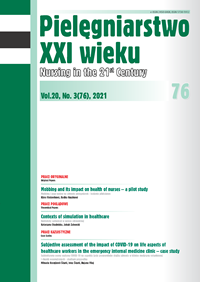Psychiatric nurses’ experiences of patient aggression
DOI:
https://doi.org/10.2478/pielxxiw-2021-0021Keywords:
nursing, aggression, psychiatryAbstract
PSYCHIATRIC NURSES’ EXPERIENCES OF PATIENT AGGRESSION
Introduction. Employees of psychiatric hospitals, especially the closed wards, experience aggression almost every day. Aggression in psychiatry is a particularly complex problem and is the subject of numerous studies. In this field of medicine, aggressive behavior of hospitalized patients is treated by the staff as an understandable, but undesirable component of work. The personnel’s confrontation with the above phenomenon is treated as a part of professional duties determined by the place of their performance.
Aim. The aim of the study was to determine the frequency of aggressive behaviors in patients and to assess their impact on nursing staff employed in psychiatric departments.
Material and methods. The study was conducted in 2017 in a group of nursing staff employed at the Clinical Hospital Dr Joseph Babinski in Cracow. The number of 196 nurses participated in the study. It was a cross-sectional study and consisted of one stage – the completion of the research tool by participants.
Results. The results showed that 94.39% of the respondents were a victim of aggressive behavior on the part of patients. The most common verbal aggression experienced by the respondents were: verbal taunts, the use of vulgar words by the hospitalized, using offensive nicknames and shouting at the staff, while physical were: destroying hospital property, attempting to hit, throwing objects and destroying own belongings.
Conclusions. The scale of the phenomenon of experiencing aggression on the part of patients in the group of nurses working in psychiatric departments indicates the need to conduct research into this subject and also to conduct staff training taking into account coping with aggressive behavior of patients.
References
1. Krasnowolski A. Zawody zaufania publicznego, zawody regulowane oraz wolne zawody. Geneza, funkcjonowanie i aktualne problemy. Kancelaria Senatu, Biuro analiz i dokumentacji. Warszawa; 2013.
2. Wojtczak K. Reglamentacja form wykonywania zawodów zaufania publicznego w rozwiązaniach prawa polskiego państw Unii Europejskiej. [w:] Zawody zaufania publicznego a interes publiczny – korporacyjna reglamentacja versus wolność wykonywania zawodu. Warszawa: Dział Wydawniczy Kancelarii Senatu; 2002.
3. Ciechaniewicz W (red.). Pielęgniarstwo. Ćwiczenia. Warszawa: Wyd. PZWL; 2006.
4. Markiewicz R. Zachowania agresywne pacjentów wobec personelu pielęgniarskiego zatrudnionego w oddziałach psychiatrycznych. Curr. Probl. of Psychiatry. 2012; 13(2): 93-97.
5. Sato M, Noda T, Sugiyama N, Yoshihama F, et al. Characteristics of aggression among psychiatric inpatients by ward type in Japan: Using the Staff Observation Agression Scale-Revised (SOAS-R). Int. J. Ment. Health. Nurs. 2017; 26(6): 602-611.
6. Podubinski T, Lee S, Hollander Y, Daffern M. Patient characteristics associated with aggression in mental health units. Psychiatry Res. 2017; 250: 141-145.
7. Urlich RS, Bogren L, Gardiner SK. Psychiatric ward desing can reduce aggressive behavior. J. Environ. Psychol. 2018; 57: 53-66.
8. Berent D, Pierchała O, Florkowski A, Gałecki P. Agresja pacjentów wobec personelu medycznego izby przyjęć szpitala psychiatrycznego. Psychiatria i Psychoterapia. 2009; 5(1-2): 13-28.
9. Kowalczuk K, Krajewska-Kułak E. Patient agression towatds different professional groups of healthcare workers. Ann. Agric. Environ. Med. 2017; 24(1): 113-116.
10. Edward KL, Stephenson J, Ousey K, Warelow P, et al. A systematic review and meta-analysis of factors that relate to aggression perpetrated against nurses by patients/relatives or staff. J. Clin. Nurs. 2016; 25: 289-299.
11. Spector PE, Zhou ZE, Che XX. Nurse exposure to physical and nonphysical violence, bullying, and sexual harassment: A quantitative review. Int. J. Nurs. Stud. 2014; 51: 72-84.
12. Dack C, Ross J, Papadopoulos C, Stewart D, et al. A review and meta-analysis of patient factors associated with psychiatric in patient aggression. Acta. Psychiatr. Scand. 2013; 127: 255-268.
13. Pekurinen VM, Valimaki M, Virtanen M, Salo P, et al. Organizational Justice and Collaboration among Nurses as Correlates of Violent Assaults by Patients in Psychiatric Care. Psychiatr. Serv. 2017; 68: 490-496.
14. Pekurinen V, Willman L, Virtanen M, Kivimaki M, et al. Patient Agression and the Wellbeing of Nurses: A Cross-Sectional Survey Study in Psychiatric and Non-Psychiatric Settings. Int. J Environ. Res. Public Health. 2017; 14(10):1245.
15. Liu J, Gary L, Evans L. Understanding Aggressive Behavior Across the Life Span. J. Psychiatr. Men. Health Nurs. 2014; 20(2): 156-168.
16. Hsien IJ, Chen YY. Determinants of aggressive behavior: Interactive effects of emotional regulation and inhibitory control. PLos One. 2017;12(4): e0175651.
17. Blair RJR. Neurocognitive models of aggression, the antisocial personality disorders, and psychopathy. J. Neurol. Neurosurg. Psychiatry. 2001; 71: 727-731.
18. Anderson CA. Effects of violent movies and trait irritability on hostile feelings and aggressive thoughts. Aggress. Behav. 1997; 23: 161-178.
19. Bushman BJ. Moderating role of trait aggressiveness in the effects of violent media on aggression. J. Pers. Soc. Psychol. 1995; 69: 950-960.
20. Mosiołek A, Koweszko T, Gierus J. Agresja w placówkach psychiatrycznych – próba zdefiniowania problemu. Psychiatria. 2014; 11(2): 87-91.
21. Nielsen MBD, Kjaer S, Aldrich PT, et al. Sexual harassment in care work – Dilemmas and consequences: A qualitative investigation. Int. J. Nurs. Stud. 2017; 70: 122-130.
22. Zeng L, Lok K-I, Feng-Rong A, et al. Prevelence of sexual harassment toward psychiatric nurses and its association with quality of life in China. Arch. Psychiatr. Nurs. 2020; 34(5): 394-397.
23. De Looff P, Nijman H, Didden R, et al. Burnout symptoms in forensic psychiatric nurses and their associations with personality, emotional intelligence and client aggression: A cross‐sectional study. J. Psychiatr. Ment. Health Nurs. 2018; 25(8): 506-516.
24. Baig L, Tanzil S, Shaikh S. Effectiveness of training on de-escalation of violence and management of aggressive behavior faced by health care providers in a public sector hospital of Karachi. Pak. J. Med. Sci. 2018; 34(2): 294-299.
Downloads
Published
Issue
Section
License
Copyright (c) 2021 Authors

This work is licensed under a Creative Commons Attribution-NonCommercial-NoDerivatives 4.0 International License.




